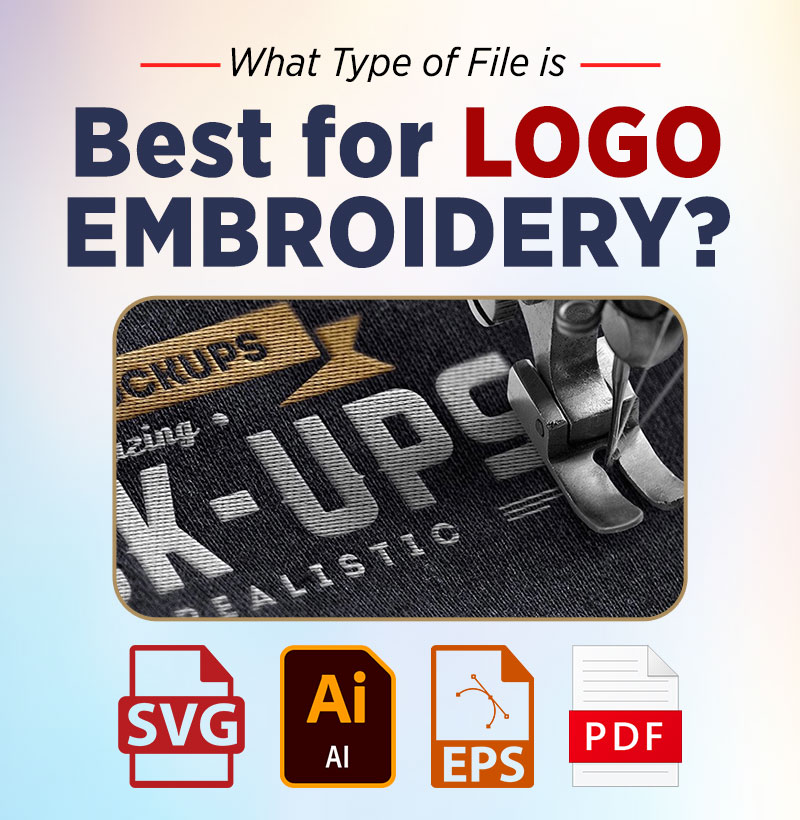File Format’s Significance in Embroidery
When it comes to logo embroidery, the type of file you use has a direct effect on the final result. Embroidery requires files with stitch-specific instructions, not just a picture, unlike digital printing. An incorrectly formatted file could result in a distorted, incomplete, or corrupted logo. For companies that order custom polos, Headwear, or jackets from sites like GotApparel, knowing the correct embroidery file format is therefore essential.
Whether you’re making promotional clothing or team uniforms, having the right file type for your embroidery machine, or the business handling your production can save time, money, and prevent poor-quality results.
Why File Format Is Important for Embroidery of Logos
Stitch Details, Not Just Image Quality
Embroidery machines operate differently than printers. Although JPG and PNG are excellent for on-screen visuals, they don’t include the stitch data needed to physically sew your logo. In reality, formats like DST or PES instruct the embroidery machine on how to handle color changes, where to place each stitch, and what order to perform them in.
Maintaining the Integrity of the Design
The logo will maintain its integrity if the file format is appropriate, particularly when it is scaled to various sizes. For example, enlarging a PNG for embroidery frequently results in undesired blur or pixelation. A properly digitized DST or PES file retains clean lines, consistent thread density, and precise design detail.
Common File Formats for Embroidery You Should Be Aware Of
- DST – A Commercial Standard
One of the earliest and most popular formats for embroidery files is DST. It was developed by Tajima and works with practically all commercial embroidery machines. Because it lacks thread color information but contains stitch data, decorators usually make use of an independent visual preview. DST is frequently the recommended format when working with a supplier like Bulk Apparel for large embroidery orders.
- PES – Ideal for Brother and Baby Lock Machines
One of the best options for users who work with Brother or Baby Lock machines are PES files. In addition to stitch placements, these files contain machine-specific instructions and thread color information. It’s a great choice for small businesses or home craftsmen who handle their own embroidery. - EXP, JEF, VP3, XXX – Machine-Specific Formats
Other file types include VP3 (Husqvarna/Viking), JEF (Janome), XXX (Singer), and EXP (Melco). All of these are made for particular embroidery machine brands and are perfect for use in those environments. To prevent compatibility problems, it’s always a good idea to inquire beforehand if you’re unsure of the format that your computer or service provider requires.
Step-by-Step: How to Prepare Your Logo for Embroidery
- Begin with a High-Quality Vector
Making sure your logo is in a vector format, like AI, EPS, or SVG, is the first step. Vector files are ideal for creating embroidery stitches since they are scalable and retain crisp edges. Although raster files, such as JPG or PNG, can be used, they frequently need extra cleaning when being digitized, particularly for intricate designs.
- Digitize the Logo for Embroidery
Your vector must be digitized after it is complete. This entails converting the artwork into a machine-readable format for embroidery. In order to prevent the logo from warping when sewed onto clothing, this entails establishing stitch types (such as satin, fill, or run), applying pull compensation, and setting underlay threads to stabilize the fabric. To create a DST, PES, or other appropriate file type, you can either use embroidery software or hire a professional digitizer. - Export to the Required Embroidery Format
After digitizing, the file ought to be exported in the format specified by your computer or the service provider. Usually, GotApparel will request a DST file if you’re uploading it for embroidered clothing. Before sending your file out for production, be sure it has a clear label and that its contents are correct.
Tips for Sending Embroidery Files to a Vendor
Give a Stitch-Ready File and a Visual Reference
In addition to the stitch file, always provide a visual proof of your logo when working with customized apparel providers or expert embroiderers. Typically, this is a PNG or JPG that displays the desired finished look. It helps prevent misunderstandings by acting as a guide for color selection and placement.
Use color codes when necessary.
A color sheet or reference is useful because not all embroidery files (particularly DST files) contain thread color information. To ensure uniformity throughout several production runs, use industry-standard threads like Madeira, Isacord, or Pantone codes.
Prior to final production, test-stitch
A test stitch sample should be requested prior to placing a large order. This lets you check the logo’s general accuracy, thread selection, size, and alignment. It’s simpler to make corrections now rather than after production has started if something seems strange.
Which Format Should You Use?
DST for Commercial Orders
DST is often the most secure and suitable format when working with a production business or uploading to websites like GotApparel. It is widely used in business contexts, effective, and machine-readable.
PES for Home Embroidery Machines
PES is frequently the preferred option for people who use Brother, Baby Lock, or comparable machines at home or in a small business setting. It functions flawlessly with brand-specific hardware and software and maintains color data.
JEF, EXP, VP3 for Specific Brands
Only select these formats if your computer or software expressly requires them. They function best when you need consistency with your tools and threads and are working in a closed-brand system.
Real-Life Scenario: Custom Polo Shirts
Suppose that a company intends to adorn employee polos with embroidered logos. They begin by using Adobe Illustrator to create a crisp vector version of their logo. The design is then transformed into a DST file, complete with stitch patterns, spacing, and direction, by hiring a digitizing service provider. In addition to color references for thread consistency, a visual preview has been added. They place their final order with GotApparel for more than 100 custom polos with embroidered logos after checking a sample stitch on scrap fabric.
The result? Clear, reliable branding that appears polished and endures several washings and wears.
Final Thoughts: Making the Right Choice
The quality of your finished output can be greatly impacted by selecting the appropriate embroidery file type. Your stitch file is the cornerstone of any project, whether you’re creating merchandise, ordering branded clothing from sites like GotApparel, or personalizing team uniforms.
Start with a vector design, get it professionally digitized, and then export it in the preferred format (typically DST or PES) for your machine or vendor. Make sure the thread colors are consistent and include clear visual references. By following these instructions, you can make sure that your embroidered logo appears as good on fabric as it does on screen.




Leave a Reply